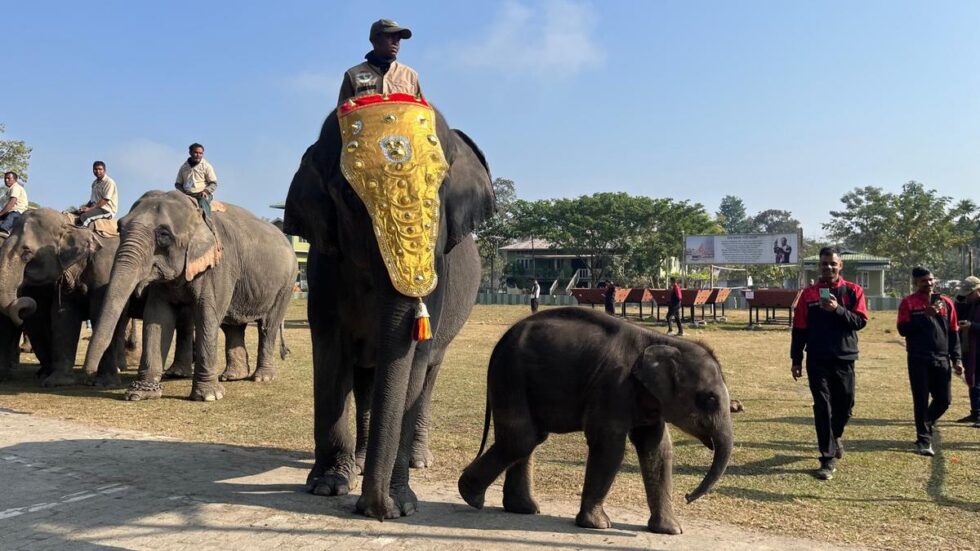
There were several cakes and baskets of fruits spread out and people gathered around, both public and forest department officials, at 8.30 a.m. on a bright sunny Saturday (January 11, 2025) morning. Next to them were scores of elephants lined up in a row. The gathering was to celebrate the first birthday of Pori, a female elephant calf and the youngest at Kaziranga, who was among the elephants standing next to her mom Badhoi. This was inside the Kaziranga National Park and Tiger Reserve.
“We have 67 departmental elephants and 44 private elephants who all assembled here today to celebrate Pori’s birthday. We took this chance as opportunity to do a health check-up of all the elephants,” said Sonali Ghosh, Director of the Kaziranga National Park and Tiger Reserve.
Of course, Pori was shy and hiding behind her mom, occasionally coming close to people only to run back. There was Goda Pani, a two-year-old male calf, he was naughty and ate most of the cake, Ms. Ghosh said referring to another calf who drew quite a bit of attention as he played pranks and disturbed everyone around.
Till one year, the calves drink only milk and after that they start eating grass, one of the mahouts there said as Goda Pani pestered him playfully from behind. “They sleep around 11 p.m. and wake up around 4 a.m,” he said.
As the cakes were cut, people who gathered around sang the birthday song and all the elephants got their treat — sugarcane, bananas and oranges. Not too long after that, Pori got bored of people and moved away to her mom and to play with Goda Pani. She is not used to such large gatherings, another mahout said.
If a mother elephant goes on a safari or a patrol, the calf also tags along, Ms. Ghosh said explaining the routine and the training process. The main part of the training is where the elephants are given a bath as they love water, she said, adding that it is a ritual to go to the nearby river where they have a bath, get a spa, cut nails and so on. They later go back into the forest to get their food, collect grass and bring it on their back. “We have babies [calves] in the camp, which doesn’t happen anywhere else.” There are currently eight calves undergoing training, which is a mix of different established methods.
All the elephants lined up there are trained, and that starts when they are 3-5 years of age, initially with a three-month rigorous training. The most unique thing about Kaziranga is that the national park cares about the elephants, be it wild elephants or the departmental ones, Ms. Ghosh, an Indian Forest Service cadre officer, said. “You will be happy to know that we have the second largest population of elephants in Assam after Manas [National Park]. In Kaziranga, we have recorded 1,200 plus elephants.”
Sonali Ghosh, Director, Kaziranga national park & tiger reserve
The process of taking care of captive elephants is an age-old traditional system in Assam. There are several treaties on elephant care. It’s a tradition and it’s part of the culture of the people, the IFS officer emphasised. “Here an elephant is not just an elephant, it’s Ganesh baba. So, it’s sacred, it’s revered. There is a lot of science and, a lot of tradition on how elephants are taken care of. From what we did here today, we tried to showcase how the elephant and the mahout have this very special bond, which is intangible. It is something which no other country, no other place has which we have here in India, where humans take care of the elephants and the elephants consider them as family.”
Kaziranga is famous for its big five (animals). Given the numbers, Ms. Ghosh said they have the world’s largest population of the greater one-horned rhinoceros (2013 rhinos as per the count in 2022), 90% of the wild buffalo population numbering almost 3,000, around 1,200 eastern swamp deer, a significant population of elephants and the Bengal tiger..
Kaziranga National Park is spread over 430 square kilometres interspersed with elephant-grass meadows, swampy lagoons, and dense forests. It is home to two-third of the world’s single-horned rhino population. The park was formed in 1908 on the recommendation of Mary Curzon, wife of Lord Curzon. In 1985, Kaziranga was declared a World Heritage site by UNESCO and as the tiger population went up over time, it was declared a tiger reserve in 2006.
Poaching was rampant earlier and some tough measures by the State government brought it down drastically and tourism saw huge increase. Assam Chief Minister Himanta Biswa Sarma referred to this two days back while speaking at the Inland Waterways Development Council. He pointed out that Kaziranga remains an example for the turnaround from severe poaching to booming tourism. Crediting his predecessor, currently Union Minister for Shipping, Ports and Waterways Sarbananda Sonowal for initiating the measures to bring down poaching, he said it is now almost zero.
“Every elephant has its own temperament and personality. And kids are kids,” Ms. Ghosh added.





